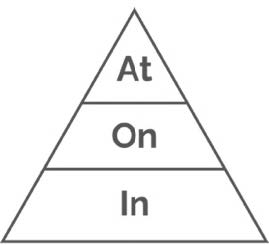Prepositions are words that signal information about location, time, or other relationships within a sentence. This guide introduces some common prepositions and directs writers toward strategies they can use to improve their preposition use. While this handout provides general suggestions, writers should always work with their audience or assignment in mind.
Prepositions indicate and clarify relationships that exist between different parts of a sentence. Prepositions can be used to illustrate location, time, or other relationships.
Prepositions that indicate location tell readers where the action of the sentence is occurring. These prepositions can also tell readers the direction of a person or thing in the sentence.
Prepositions that indicate time tell readers when something occurs. Some of these prepositions establish time in relationship to other events, while others can be used to describe the exact time something occurred.
Prepositions can also indicate a variety of other relationships, including the way an action was performed, the cause of an event, or other more abstract connections.
Because prepositions are often not governed by specific rules, many writers find them difficult to use. The following tools and resources can be helpful for learning preposition usage.
Because prepositions can have multiple and contextual meanings, many writers struggle to use the right preposition. Some of the most commonly confused prepositions are at, on, and in; these prepositions are often used to describe location and time. Each of these words is used in different ways:

The following chart explains some of the usage for at, on and in.
| Location | Time | |
|---|---|---|
| At | Used for the name of a place or a street address.
|
Used for times on the clock or other named times.
|
| On |
Used for street names without a specific address.
|
Used for days of the week and dates.
|
| In |
Used for cities, states, countries, and continents.
|
Used for months, years, seasons, and times of day.
|
When a preposition is followed by a noun or pronoun, together they make up a prepositional phrase. The noun or pronoun is called the object of the prepositional phrase. A prepositional phrase is not a complete sentence on its own. It requires a subject and a verb to be complete.
Verbs describe action and normally wouldn’t be the object of a preposition; however, gerunds (or verbs ending with -ing) act like nouns and can be used in a prepositional phrase.
Some verbs have prepositions attached to them. These verbs are called phrasal verbs and do not always require an object to be complete. Some examples of phrasal verbs include sit up, find out, and set aside.